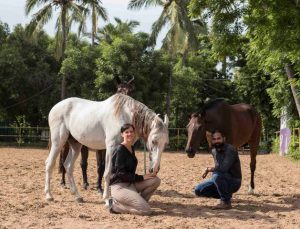Horse Whisperers in Business
Horse riding or equestrian sport is a great way to fine tune non-verbal communication and leadership skills.

H ave you ever seen horses coaching managers on effective leadership strategies? My guess is, not yet, as this concept has just been launched in India!
This training concept called the Horse Dream Concept has its roots in Germany, where you can see forward-thinking managers of Fortune 500 companies developing leadership skills with the help of horses.
“Horses respond to body language and even pick up on the energy and intention of humans. That’s the reason why some people who have a very close connection with horses are called “Horse-Whisperers” because even without whispering, the horse picks up subtle signals of a person and responds to it.”
There are hundreds of books written on the “secrets to success” in management and most of them share very effective strategies on how to be a better leader. The only problem is the implementation. The most effective way to learn is by hands-on experience, that’s something we often miss out on, in our virtual and high-tech lives.
Let’s take a young aspiring manager for example, he might have all the credentials to become a great leader but until he actually leads a team and gains experience, the theoretical knowledge will not help him to develop into an effective leader. For any company, it’s a challenging task to bring their future leaders to the next level, without compromising the performance of the team and allowing new leaders to make mistakes.
The workshop with horses gives leaders, the rare opportunity to experiment and experience different leadership styles. The sessions with the horses are focused on generating enthusiasm, building trust and engaging in clear communication.
Participants practice with the horses, analyse in the group and reflect their own behaviour encouraged by the trainer. It starts with simple exercises where they lead the horse to more advanced challenges where they need to trust others and direct horses purely based on their body-language. Emotional intelligence and authenticity are developed without fear of failure.
“For many participants, it is the first time that they are interacting with a horse. Some of them may be fearful of these large animals but within minutes, it is all forgotten. It is part of the training to overcome obstacles and expand one’s comfort zone, as these are integral qualities of great leaders.”
Can you remember the boring introduction of some professors and trainers? They start on where they have studied 30 years ago, and then you fall asleep.
However, the horses introduce themselves in a different way: 5 horses gallop free in a large arena and you can even feel the vibration off the ground. Some show off their power, beauty and elegance while others like to get close to the people watching at the fence. While observing horses, even people who have no contact to animals, can see a fascinating similarity of the horses’ interaction, and the communication with colleagues at the office.
“The first challenge for the participants is to find out the hierarchy of the group of horses. The horses don’t carry around business cards, but with an eye for detail, many can identify the leader of the herd.”
 Leadership is about leading, and that’s easier said than done. A few minutes into the training, participants are handed a rope and a horse: their task is to lead the horse through a small course of obstacles. After getting comfortable with a 500 kg animal following in their footsteps, they start to realise that the horse mirrors their behaviour.
Leadership is about leading, and that’s easier said than done. A few minutes into the training, participants are handed a rope and a horse: their task is to lead the horse through a small course of obstacles. After getting comfortable with a 500 kg animal following in their footsteps, they start to realise that the horse mirrors their behaviour.
Confident people who can motivate the horse will discover that the animal follows them close behind through every obstacle, while some who like to enforce too much control or display a sluggish attitude face difficulties.
It’s learning by doing – and participants who face challenges during the first exercises adapt their behaviour – later can master the advanced exercises as well.
Every person in a team has individual preferences when it comes to work attitudes. Some people work best in a team, some like to be on their own and others need an eagle’s eye watching them all the time. For a leader, it’s important to adjust his or her style according to the situation and person. This is practiced with the horses.
“Participants are asked to lead in different styles: switching between authoritative leadership, being a team player and leading by example. In times of change, it takes leaders who are flexible and can lead in challenging situations.”
After a full day with the horse, participants develop more empathy, authenticity and emotional intelligence. A leadership evaluation as well as a short self-assessment is part of the workshop to deepen the learning. The managers who have experienced this call the horses one of the best “Leadership-Coaches” they have worked with.
One needs to experience it first-hand, step into the ring and get ready for an interaction with these beautiful animals.
“Workshops are conducted by Isabelle Hasleder at HQ Leadership India in Chennai as well as Bengaluru. The training is beneficial for managers at all levels, and does not require any prior experience with horses.”
More information and videos at www.LeadershipHorses.com
